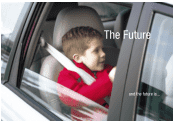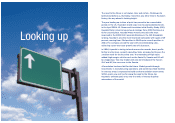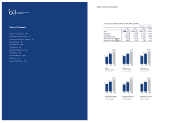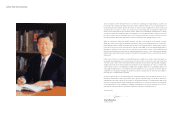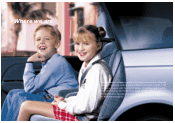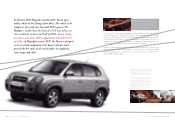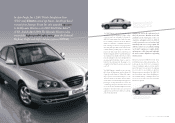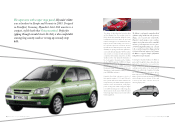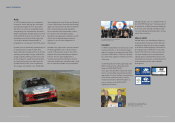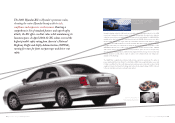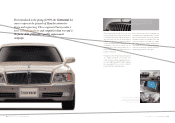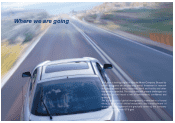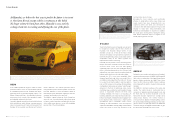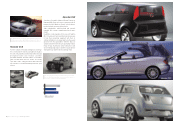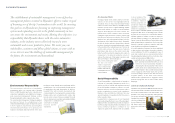Hyundai 2003 Annual Report Download - page 13
Download and view the complete annual report
Please find page 13 of the 2003 Hyundai annual report below. You can navigate through the pages in the report by either clicking on the pages listed below, or by using the keyword search tool below to find specific information within the annual report.
Hyundai Motor Company Annual Report 2003 _2423_Hyundai Motor Company Annual Report 2003
Tucson uses the state-of-the-art Borg-Warner Electronic
InterActive Torque Management four-wheel-drive system that
routes up to 99 percent of the available power to the front
wheels. As road conditions or torque demand changes, the
system automatically diverts up to 50 percent of the available
power to the rear wheels. The system monitors throttle
position, front wheel angle and slippage.
In parallel with the development of the standard Tucson,
Hyundai has been working on the Tucson FCEV as part
of the Hyundai’s advanced Fuel Cell Program. The
FCEV debuted at the 2004 Geneva Auto Show and was
presented at the New York International Auto Show.
Code-named FJM by its developers, the Tucson FCEV
will have an extended driving range plus cold weather
starting capability. It will incorporate numerous
technical advances including a higher output fuel cell and
a new lithium ion polymer battery. Unlike the Santa Fe
FCEV, the Tucson Fuel Cell program has been running
on a parallel path with the conventional Tucson
providing fully digitized engineering data from the
earliest stages.
In January 2004 Hyundai introduced the Tucson sport
utility vehicle at the Chicago Auto Show. The vehicle is the
company’s first entry into the small SUV segment. The
Tucson is smaller than the Santa Fe SUV and will go on
sale worldwide in the second half of 2004. Tucson styling
provides a masculine, athletic appearance and delivers lots
of utility. As Hyundai’s newest SUV, the Tucson is designed
to be a versatile companion to the buyer’s lifestyle and to
provide the best value in the market place in equipment,
style, image and value.
The base model Tucson GL features Hyundai’s proven 2.0-liter DOHC 4-cylinder engine fitted with
Continuously Variable Valve Timing (CVVT) matched to a 5-speed manual transmission or available
Shiftronic automatic transmission. A 2-liter turbocharged diesel with will be supplied as standard in
the Korean market and will also be available in the European and other markets. The Tucson is
equipped with a total of six airbags; driver and passenger front airbags, driver and passenger side-
impact airbags and side curtain airbags for both front and rear seat occupants.
Hyundai’s 2.7-liter DOHC V6 is standard on the GLS and LX models and it is matched to the
Shiftronic automatic transmission. The 2.7-liter V6 as used in the Tucson is fitted with a variable
length, tuned intake system for smoother delivery of power across the entire rev band. Four-wheel-
drive is available with either engine.


